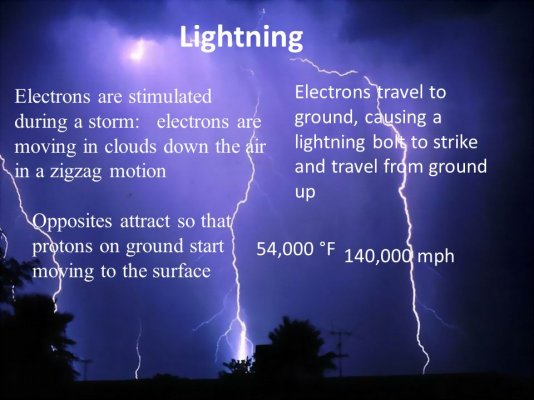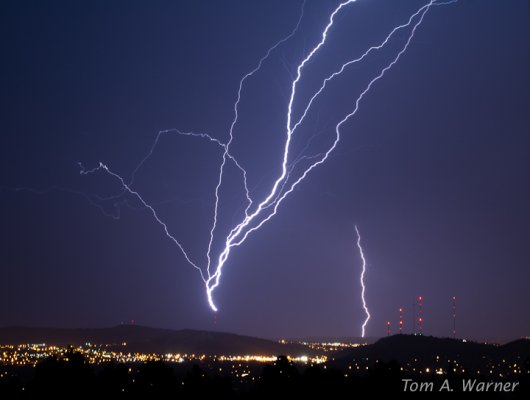I have bookmarked that, it should come in handy. Although quite often where we seem to be is where the storm is :masterdrago said:When I worked in the A/C repair and Appliance business, I saw where a strike hit a tree a few feet from a house corner, jumped to a condensing unit cracking the concrete and moving the unit 8", moving somehow across the house jumping off a turn-off vlv under a commode, blew a 2" hole in the floor, and jump off a 1/4" water line to the refrigerator on the other side of the house. I think it ignored all other paths to grounded stuff. Found this to be a good link to monitor when having antennas up. http://en.blitzortung.org/live_dynamic_maps.php
You are using an out of date browser. It may not display this or other websites correctly.
You should upgrade or use an alternative browser.
You should upgrade or use an alternative browser.
Lightning
- Thread starter Dauninge
- Start date
The friendliest place on the web for anyone with an RV or an interest in RVing!
If you have answers, please help by responding to the unanswered posts.
If you have answers, please help by responding to the unanswered posts.
Back2PA
Well-known member
- Joined
- Jul 26, 2015
- Posts
- 5,766
masterdrago said:I think it ignored all other paths to grounded stuff.
Yup. It's a common misconception that the tires of your car offer protection. But in reality that lightning bolt just traveled anywhere from one to several miles through no other conductor than the air; that last 6" of space offered by the tires isn't going to do much good. It's the Farady Cage principle that allows the charge to travel around the occupants through the frame leaving them unharmed. Same reason airplanes can be hit all the time without hurting anyone. The most damage to an airplane is typically caused when the charge leaves and continues on its way.
masterdrago said:Found this to be a good link to monitor when having antennas up. http://en.blitzortung.org/live_dynamic_maps.php
Wow, what a great site! Bookmarked
Rene T
Site Team
I remember years ago when I was on the Fire Dept. and we responded to a grass fire and a woods fire. We arrived at the scene and found that lightning had hit a huge pine tree and split it down the middle. It then went about 200' in the ground creating a trench about 3' wide and 2' deep. There were boulders weighing about 200 lbs. thrown off to the side. It then went out into the open field starting multiple grass fires. I respect lightning after seeing that.
John From Detroit
Well-known member
Regarding the "Tires will protect you" I always laugh when I read that.. Then I shake my head in disbelief.
you have a bolt of electricity that is going to jump an air gap thousands of feet in length. What's a few more inches????? (Nothing)
NOTE: IF I RECALL correctly,, Lightning does not strike the earth, it strikes the clouds. that is the direction the current flows. no matter how we normally picture it. Still When it starts flying, best place to be is ELSEWHERE.
you have a bolt of electricity that is going to jump an air gap thousands of feet in length. What's a few more inches????? (Nothing)
NOTE: IF I RECALL correctly,, Lightning does not strike the earth, it strikes the clouds. that is the direction the current flows. no matter how we normally picture it. Still When it starts flying, best place to be is ELSEWHERE.
Back2PA
Well-known member
- Joined
- Jul 26, 2015
- Posts
- 5,766
John From Detroit said:NOTE: IF I RECALL correctly,, Lightning does not strike the earth, it strikes the clouds. that is the direction the current flows. no matter how we normally picture it.
"Does lightning strike from the sky down, or the ground up? The answer is both. Cloud-to-ground lightning comes from the sky down, but the part you see comes from the ground up. A typical cloud-to-ground flash lowers a path of negative electricity (that we cannot see) towards the ground in a series of spurts. Objects on the ground generally have a positive charge. Since opposites attract, an upward streamer is sent out from the object about to be struck. When these two paths meet, a return stroke zips back up to the sky. It is the return stroke that produces the visible flash, but it all happens so fast - in about one-millionth of a second - so the human eye doesn't see the actual formation of the stroke."
I believe this is why, if you are in the immediate vicinity of a spot about to be struck, you may get a few second warning as the charge starts to build. People have reported their hair standing on end, tingling, etc. Running back in a building (if close), running and lying down in a ditch or at least getting flat on the ground is the recommended action
Molaker
Well-known member
I thought you were supposed to bend over and put your head between your legs.Sun2Retire said:.....I believe this is why, if you are in the immediate vicinity of a spot about to be struck, you may get a few second warning as the charge starts to build. People have reported their hair standing on end, tingling, etc. Running back in a building (if close), running and lying down in a ditch or at least getting flat on the ground is the recommended action
Back2PA
Well-known member
- Joined
- Jul 26, 2015
- Posts
- 5,766
Molaker said:I thought you were supposed to bend over and put your head between your legs.
Only if there isn't a ditch, house or car really, really close
Sun2Retire said:)
"Does lightning strike from the sky down, or the ground up? The answer is both. Cloud-to-ground lightning comes from the sky down, but the part you see comes from the ground up. A typical cloud-to-ground flash lowers a path of negative electricity (that we cannot see) towards the ground in a series of spurts. Objects on the ground generally have a positive charge. Since opposites attract, an upward streamer is sent out from the object about to be struck. When these two paths meet, a return stroke zips back up to the sky. It is the return stroke that produces the visible flash, but it all happens so fast - in about one-millionth of a second - so the human eye doesn't see the actual formation of the stroke."
I believe this is why, if you are in the immediate vicinity of a spot about to be struck, you may get a few second warning as the charge starts to build. People have reported their hair standing on end, tingling, etc. Running back in a building (if close), running and lying down in a ditch or at least getting flat on the ground is the recommended action
Here are a couple of images I found on the web....
Attachments
Lou Schneider
Site Team
- Joined
- Mar 14, 2005
- Posts
- 13,250
In the 1980s I was in charge of a 50,000 watt AM transmitter site. It was in the middle of farmland with (4) 500 ft. towers that would occasionally be hit by lightning, causing damage and loss of airtime.
When we installed a new transmitter we also added lightning eliminators that looked like large toilet brushes to the top of each tower - lots of pointy bits to dissipate the upward streamer before it had a chance to form.
A few weeks later I was called out to the site because the transmitter had kicked on and off the air several times. When I got there I asked the farmer who owned the adjacent land if anything unusual had occurred.
He pointed to ground strikes outside of our property on all 4 sides of the towers and said it was the strangest thing he had ever seen. A thundercloud had formed overhead but instead of hitting the towers, the lightning struck the surrounding land. The resulting surges were enough to trip the overload circuits in the transmitter, but each time it returned to the air on it's own and there was no damage.
When we installed a new transmitter we also added lightning eliminators that looked like large toilet brushes to the top of each tower - lots of pointy bits to dissipate the upward streamer before it had a chance to form.
A few weeks later I was called out to the site because the transmitter had kicked on and off the air several times. When I got there I asked the farmer who owned the adjacent land if anything unusual had occurred.
He pointed to ground strikes outside of our property on all 4 sides of the towers and said it was the strangest thing he had ever seen. A thundercloud had formed overhead but instead of hitting the towers, the lightning struck the surrounding land. The resulting surges were enough to trip the overload circuits in the transmitter, but each time it returned to the air on it's own and there was no damage.
Back2PA
Well-known member
- Joined
- Jul 26, 2015
- Posts
- 5,766
Lou Schneider said:lightning eliminators that looked like large toilet brushes to the top of each tower - lots of pointy bits to dissipate the upward streamer before it had a chance to form.
Interesting. Wondering if that explains the sometimes funny shaped lightning rod you'll see on old farmhouses.
Large airplanes use identical technology - they're called static wicks. Roughly 10" in length, they can be seen along the trailing edge of the wings and empennage. Dissipates the charge on the aircraft and sometimes also offers an "exit path" if a strike does occurs
Back2PA
Well-known member
- Joined
- Jul 26, 2015
- Posts
- 5,766
jackiemac said:Have you heard of this place?
https://www.diaart.org/visit/visit/walter-de-maria-the-lightning-field
I have not. I'd be hesitant to visit on anything other than a clear day


